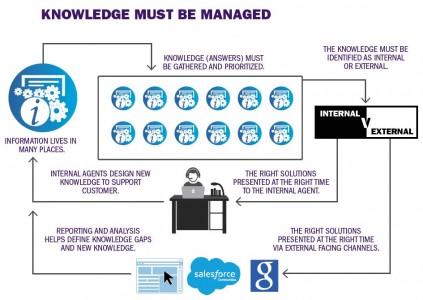Redefining Knowledge Management

I RECENTLY SPOKE WITH A NEW CLIENT ABOUT HIS GOALS FOR SUCCESS WHEN PLANNING THE IMPLEMENTATION OF A NEW CRM APPLICATION. He shared several, but prioritized the following as the most important: “We need to reduce handletime and improve first-call resolution.”
At Bluewolf, we hear that often as we work with clients to define a roadmap for success. As we continued to talk, I asked about several key elements of functionality—case management, CTI integration, workflows… When I got to knowledge management, I was surprised at his response: “We’re not planning to do that right now. In fact, we don’t see that as part of Phase 1 or Phase 2. We’re not sure that we’ll get the value for the work required.”
I thought, “Wait, how is that possible?” If the top goals are to “reduce handle-time and improve first-call resolution,” how can knowledge not be part of the plan? As we discussed the functionality more, he said something else that we hear often, “Knowledge, for us, just seems really hard. Our knowledge is all over the place and owned by a lot of different organizations. We know it could help, but it just seems impossible to get our arms around.”
There it was: the reason many companies don’t tackle knowledge management. They think it’s too hard! In my opinion, tackling knowledge management needs to be redefined. It is not hard, but complex.
We do, however, work with companies that have seen the amazing return on investment that is possible. But even they face challenges that make the path complex.
Knowledge Must Be Managed
There are five challenges that most companies face when they decide to go down the path to knowledge management:
- Knowledge is everywhere—across many systems and applications.
- The processes to identify and manage knowledge are, at best, cumbersome.
- Most companies don’t have easy ways to author knowledge today.
- Most organizations lack real structure to manage knowledge.
- In many cases, current technology does not support knowledge management.
Each of these is ominous in its own way. Knowledge is everywhere—and customer service is consistently the place where all knowledge has to come together to support the customer effectively. And while it may not be a role that the support leader relishes, there is no one in the company better suited to lead the effort to create consistent structure, processes and resources to write, publish and manage knowledge—for customer service and for the rest of the company.
So how does one get started with knowledge management? You may have heard the expression, “How do you eat an elephant? One bite at a time!” The same can be said for knowledge; the rewards are great, and success almost always results in better service, support and improved metrics in the customer service organization.
So where do we start?
First, successful knowledge management is mostly about “management.” It is not about the application, although that is immensely important. It is more about the plan and the structure that is built around the management processes.
Managing knowledge is a continuing loop of work. Basic steps include: defining knowledge for your team, identifying where the knowledge lives, prioritizing it, editing/validating that it is either for internal consumption, external consumption or both—and then defining how you will manage it in either situation.
The knowledge then enters the loop again and is redefined, reprioritized and republished as needed
Knowledge Definitions Are Key
At Bluewolf, we work with customers of all sizes and business verticals. We have identified six categories of knowledge, although there are always exceptions and additions depending on specific business needs.
- Resolution-based—includes the typical question/solution article-type knowledge. As you start your knowledge process, this is the information that typically lives in training and in the heads of your agents. They have a question and need a consistent answer. The question/solutions are often related to products and services.
- Policies and procedure—includes basic standard operating procedures. It can still be formatted into article-style question/answer, but focuses on the “how” as it relates to company policies and procedures.
- Regulatory and compliance—includes legal requirements and compliance issues; forms or processes that must be followed due to safety or regulatory requirements.
- Marketing collateral—includes marketing collateral, brochures and product or service details.
- Product documentation—includes product diagrams and schematics, manuals, product guides, etc.
- FAQ—includes frequently asked questions—typically provided on websites and portals. You might decide that this is an output of other categories, but companies still need to confirm the ability to manage and update FAQs, wherever they live.
Defining what is knowledge, and then confirming where it lives (websites, databases, content management systems, emails, SharePoint, etc.), allows companies to clearly define ownership and prioritize the use in the contact center (internal) and by customers (external). We suggest that our customers create a matrix that pulls together the bits of information into a single document which becomes the basis for all future planning and implementation.
Knowledge Is Messy
I love this quote by ServiceInnovation.org: “Knowledge is not pristine, static or approved by experts. It is messy, constantly changing and validated through use.”
Knowledge is messy. As mentioned before, the most common description I hear is, “It’s everywhere!”
But most companies have the most problems with the statement, “not approved by experts.” The question arises, “How can we allow unapproved knowledge to be delivered to agents—and eventually to customers?” I had someone tell me that this makes the hair on the back of his neck stand up.
This is where the concepts of KCS (Knowledge Centered Support) can factor into your knowledge management strategy. ServiceInnovation. com’s KCS Methodology describes the process of managing knowledge by creating a clear plan around several key elements, including:
CREATE CONTENT AS A BY-PRODUCT OF SOLVING ISSUES
This is where the concept of real-time authorship comes into play. You need a system or application that allows agents to search for the answer—and, when the answer does not exist, they need to be able to author a knowledge article when they find the answer.
As a former agent, I remember my process for looking for an answer. I might flip open a book, search in my recent emails, ask the person next to me or even ask a supervisor. But the part that was missing is the key to knowledge success—and I can only imagine how much more productive I would have been if I could have immediately authored a solution once I found the answer. When this is part of the knowledge process, it means that not only could the agent now find the answer in the future, but so can every other person who accesses the knowledge base. And in a perfect world, I, or the next agent who accesses it, would have the ability edit, improve, expand and improve on the answer. If you refer back to the quote: Knowledge is not pristine or static—it is ever-changing and improving.
EVOLVE CONTENT BASED ON DEMAND AND USAGE
The knowledge process must have a subprocess that allows for the prioritization of knowledge. The technology users need to be able to score knowledge based on the success—and to prioritize this knowledge to the top. As agents use the knowledge and edit and improve it, there must be ways to track success and bring the best knowledge to the top. When you are choosing a knowledge management vendor, be sure to understand how the application “learns” success. And how it brings that knowledge forward, based on usage and/or scoring.
CREATE A KNOWLEDGE BASE OF COLLECTIVE EXPERIENCES TO-DATE
Every center has a long-standing “John” or “Betty”—that person who has been with the company for 10, 20 years or longer. The person who everyone goes to when they cannot find the answer anywhere else. Betty usually has a lot of tribal knowledge in her head. She has been with the company a long time, and if she does not know the answer, she knows where to find it. So, any successful knowledge strategy needs to include a path to pulling knowledge out of Betty’s head into the knowledge base. And, in reality, it is the same for any and all agents. What do they know that they share with others? What do they know about how to solve problems that they can create into a knowledge article? This is another example of the magic of frontline agents being able to create and author knowledge in real-time.
REWARD LEARNING, COLLABORATION, SHARING AND IMPROVING
Solve this expectation and you will see knowledge management embraced in ways you never imagined. We have found that most agents want to feel like their work is important. If they have tools to reward them for collaboration and sharing of knowledge, many will participate in the knowledge process. I recently had a client tell me that she thought this was the most important part of the entire knowledge roadmap. There are many ways to do this—both manually and through gamification applications. The key is to find ways to reward collaboration across all areas of the company.
Effective Knowledge Management Drives Engagement and Value
Understanding the nuances of each of the six categories of knowledge, and creating a plan to manage and improve each one, provides a way to provide improved support to customers.
While measurements like improved handle time and first-contact resolution will also be important, the real goal should be an improved customer experience. Knowledge management drives engagement among employees and agents—thus driving more value to customers. The overall experience is better because individual customer moments are improved when employees have the right answers at the right time.
Bob Furniss is the Director of Bluewolf’s Service Cloud Practice and leads a team of consultants focused on improving customer experiences.
– Reprinted with permission from Contact Center Pipeline, http://www.contactcenterpipeline.com





